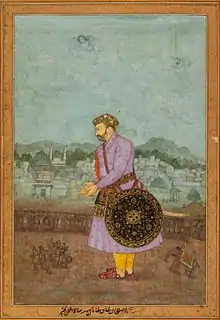Vakil of Mughal Empire
The Vakil of Mughal Empire (Urdu: وکیلِ سلطنت مغلیہ), officially the Vakil-i-Mutlaq (Urdu: وکیلِ مطلق, literally: "Representative of Emperor"), was an exalted office in Mughal administration, first in ministerial hierarchy and only next to Mughal Emperor. Vekil is Arabic word which means lawyer.[1] Vakil was considered as the Emperor's lieutenant in all matters connected with the realm and household. From the reign of Emperor Babur to Emperor Shah Jahan, the title of Grand vizier was also given to vakil. But afterwards it remained only as dignitary post.[2]
| Vakil of the Mughal Empire | |
|---|---|
| Style | His Excellency |
| Residence | House of Rule |
| Appointer | The Emperor |
| Formation | 1526 |
| First holder | Mir Khalifa |
| Final holder | Daulat Rao Sindhia |
| Abolished | 1818 |
The degree of powers of vakil's office varied from era to era. However vakil required Emperor's approval in each and every decision. During era of Babur and Humayun, it had the powers of prime minister while during early era of Akbar, Vakil Bairam Khan acted as regent and ruled on the behalf of Emperor. In 1564, Akbar revived the office of vakil and didn't give him the responsibilities of finance department.[3] In reign of Jahangir, the office of imperial diwan gained prominence and ultimately during Shah Jahan's regime, the title of Grand Vizier was transferred from Vakil's office to Imperial Diwan.[3]
See also
- Vakil Munim Khan, successor of Bairam Khan
References
- Malik, Dr Malti (1943). History of India. New Saraswati House India Pvt Ltd. ISBN 978-81-7335-498-4.
- "Mughal Administration: Key Features & Structure". Jagranjosh.com. 2015-10-21. Retrieved 2020-06-03.
- Mehta, Jl. Advanced Study in the History of Medieval India. Sterling Publishers Pvt. Ltd. ISBN 978-81-207-1015-3.

